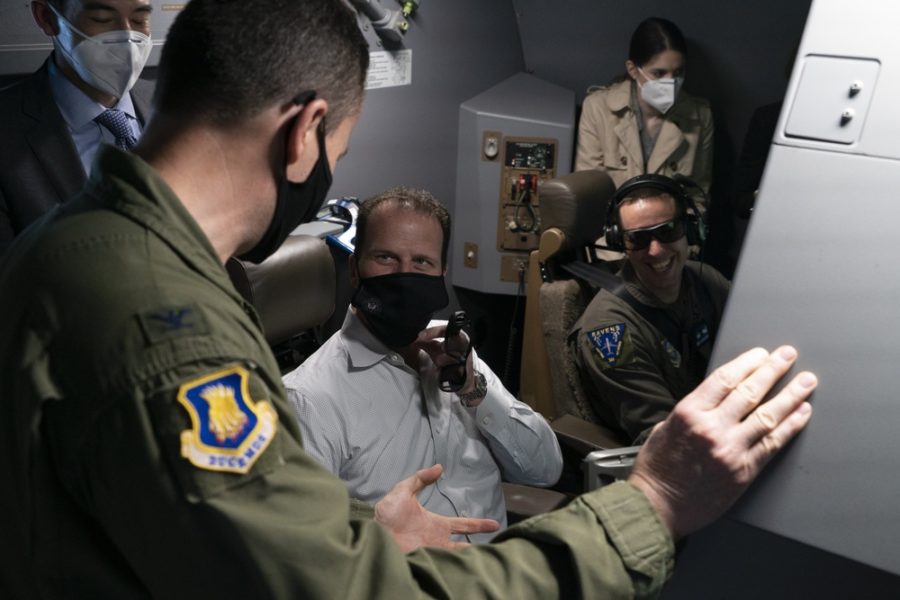In May 2020, Rep. Mike Garcia (R-Calif.) was sworn into Congress and became part of a select group of lawmakers to with experience as a military aviator—he flew F/A-18s as an officer in the Navy.
Now, nearly two years later, that group has expanded significantly, and they’ve come together to form a brand new caucus.
The Mach 1 Caucus, officially announced Feb. 3, will unite Garcia, Rep. August Pfluger (R-Texas), Rep. Jake Ellzey (R-Texas), and Rep. Scott Franklin (R-Fla.) as advocates for fighter jets and their pilots—with firsthand experience in the matter.
“The reality is, we went from, really in the House, not having any members who had a fighter pilot background or tactical air background in the military, to four of us in the span of a year or so,” Garcia told Air Force Magazine in an interview. “And so we got together and we just started to talk about how do we optimize this? How do we turn our experiences into something that can benefit not only other House members, but also our nation’s security?”
Like Garcia, Ellzey and Franklin were both Naval aviators—Garcia and Ellzey even flew together in combat operations. Pfluger is the lone Air Force representative of the bunch; he flew F-15s and F-22s over the course of nearly 20 years in uniform.
All four lawmakers are relatively new to Congress, but given their fairly unique backgrounds, they believe they have an especially powerful voice when it comes to airpower issues.
“It’s really important that people who have been there, who have flown really, really advanced weaponry—myself, the F-22, the other guys, the F/A-18 and some other planes—it’s important that we act as translators,” Pfluger told Air Force Magazine in an interview. “That we synthesize some of the threat information, and then really speak on behalf of airpower to the appropriate committees and to the leaders.”
Their decision to band together and advocate for air dominance, both Garcia and Pfluger said, was driven principally by the threat posed by competitors like China.
“This conversation is really focused on China. We need ‘big A’ Airmen … everyone in the joint air fight, in the air dominance side of warfare, we need to provide them every tool possible to defeat whatever threat is coming out of any country, but specifically as we focus on China,” said Pfluger.
Their goal is to be a “Rosetta Stone” for their fellow lawmakers, capable of explaining the complexities of the military services’ fighter and attack platforms. That could be especially important as the Air Force and Navy look to retire their older assets and procure funds to buy new ones, like the F-35.
“In this environment, where we have a major threat in the form of China, the airpower, the air superiority, and the planning and budgeting and appropriations behind these programs becomes extremely critical,” Garcia said. “And the average member, especially in the House, really doesn’t understand what these programs are, what they do, what these platforms are, what their missions are.”
But it’s not just the planes themselves that will get the Caucus’ attention. Garcia said he’ll also look to advocate for more flying hours to improve pilots’ training, saying focus on training has “atrophied” in recent years during the conflicts in Iraq and Afghanistan.
“You need a significant bump in in flight hour funding to get the proficiency levels up to where they need to be,” Garcia said. “And you know, in some squadrons right now, they’re flying 10 to 20 hours a month. And that’s unacceptable, even against a lower intensity conflict kind of mission, but to go against something like China requires a lot more than that.
Both Garcia and Pfluger said they want the Caucus to help address the services’ pilot shortages, by working to ensure better pay and quality of life for military aviators. Doing so, they said, is a competitive necessity.
“Our government spends anywhere from $2 to $3 million per pilot, getting them trained to go to the fleet, and after seven or eight years, they have the option to get out,” Garcia said. “And if we can’t provide the quality of life to incentivize them to stay in, we effectively lose that investment and we’ve got to start all over with new pilots.”
One quality of life issue that has become an increasingly public concern for the fighter pilot community is the rate of cancers among aviators. A recent Air Force study showed fighter pilots between 1970 and 2004 were statistically more likely than their non-flying peers to be diagnosed with and die from certain kinds of cancers, particularly melanoma skin cancer and prostate cancer.
“I see the Mach 1 Caucus as championing several issues this year. We’ll pick our priority issues, and there probably will be technical issues. But I can guarantee you that this will be one of them; we will be looking very closely at the cancer rates,” Pfluger said.
Already, the caucus has had a meeting with Air Force Secretary Frank Kendall to “make sure that we understand where his head is at and how we can help,” Garcia said, and the members plan to continue connecting key figures in the Pentagon and industry with other members of Congress.
But while other Congressional caucuses like the Airborne ISR Caucus, Joint Strike Fighter Caucus, and Long-Range Strike Caucus include a broad range of Representatives, not all of whom are veterans, the Mach 1 Caucus will likely keep its membership list short, limited to those with fighter pilot experience, Garcia said.
There could be at least one addition later this year though—one of Garcia and Ellzey’s fellow Navy pilots, Matt Stoll, is currently running in a special election in California scheduled for its first round of voting in April.
Should Stoll win, it would give the caucus a decidedly heavy Navy tilt, not that Pfluger seems to mind.
“It takes three Navy pilots to compete with one Air Force pilot,” Pfluger joked about the current group.
